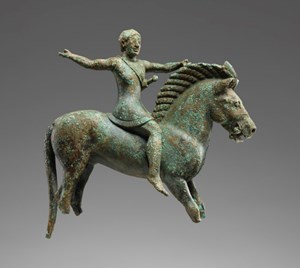
Following its treatment and analysis by Getty Museum conservators, the bronze will be shown to the public for the first time since its excavation in 2018. Dating from around 500 BC, when the region was inhabited by Greek colonists, the statuette is an exceptional work of Archaic Greek art and a unique example of Albania’s rich archaeological heritage.
“Although bordering on Greece and sharing the Adriatic coast with Italy, Albania is a country whose ancient heritage is less familiar to American museum audiences,” says Timothy Potts, Maria Hummer-Tuttle and Robert Tuttle Director of the Getty Museum. “Focusing on a single, precious object allows us to offer visitors a glimpse into the close artistic connections within the Mediterranean world, and to highlight the complex process of restoration by the Museum’s antiquities conservators, who carried out the analysis and treatment of this delicate archaeological find in collaboration with colleagues at the Albanian Institute of Archaeology in Tirana.”
In 2018, archaeologists excavating an ancient Greek settlement in the Republic of Albania discovered an extraordinary bronze statuette of an armed rider on a well-groomed horse. Even with many of its details obscured by the soil adhering to the surface, the figure’s outstanding craftsmanship was immediately apparent, on par with the most refined bronze work produced in Greece.
“The discovery of this rare find and the subsequent conservation work,” says professor Belisa Muka, director of the Albanian Archaeological Institute in Tirana, “are evidence of a very successful international partnership between our institution, the German Archaeological Institute, Humboldt Universität, Berlin, and the Getty Museum.”
Horseback riders were a popular subject in Greek vase painting and small-scale sculpture from the Archaic period (800–480 BC), but only a few are known in bronze—and fewer still have a known findspot. Scholars believe that many of these bronzes were made in Corinth, Greece, an important center for metalworking at this time. The horseman from Albania makes a connection to Corinth more plausible, as it was discovered near the site of the Corinthian colony of Apollonia.
In 2021 the Albanian Institute of Archaeology entrusted the bronze horseman to the Getty Museum’s conservation team in the same condition in which it had been found—caked with soil and partly corroded. Conservators consulted with colleagues of the German-Albanian project in devising a plan for the object’s treatment and future care. “It has been a privilege to work on this extraordinary small bronze,” says Susanne Gänsicke, senior conservator of antiquities at Getty, who led the conservation effort, “and to be able to reveal details of decoration that were not recognizable before conservation treatment.”
The exhibition reveals the results of the conservation process and situates this unique example of Albania’s archaeological heritage within the region’s rich ancient history. In addition, two Archaic small-scale bronze figures from the Getty collection will be on display, inviting comparisons with the unprecedented loan from Albania.
Image : Statuette of a Horse and Rider, 520–500 BC, Greek. Bronze, 5 9/16 × 5 7/16 × 2 3/16 in. Albanian Institute of Archaeology, Tirana VL.2020.1

ArtDependence Magazine is an international magazine covering all spheres of contemporary art, as well as modern and classical art.
ArtDependence features the latest art news, highlighting interviews with today’s most influential artists, galleries, curators, collectors, fair directors and individuals at the axis of the arts.
The magazine also covers series of articles and reviews on critical art events, new publications and other foremost happenings in the art world.
If you would like to submit events or editorial content to ArtDependence Magazine, please feel free to reach the magazine via the contact page.